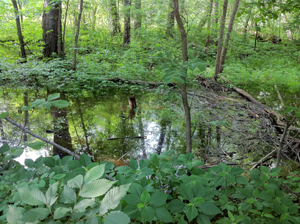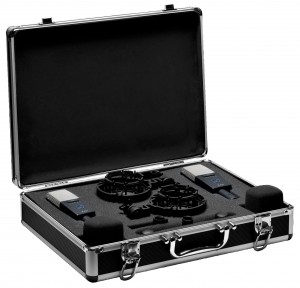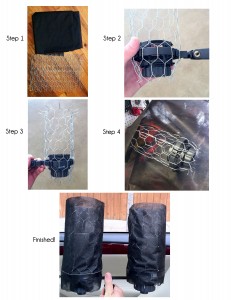Psyched on Sonics: Remote Recording for a Sound Effects and Sample Library
Every month, Matt McCorkle of EqualSonics.com brings you a day in the life of a New York City recording engineer.
THE MISSION: Build A Sound Effects and Sample Library
For this entry, I’ll be taking you on a journey far away from any type of man-made structure, much less a recording studio. We’ll be venturing into the deep wilderness of the north woods of Wisconsin. This adventure marks the beginning of a massive sound effects and sample library that I’m building.
This library will include everything from environmental ambience recordings, thunderstorms, engine noises, dishwashers cycling, kick drums, trumpet licks and pretty much anything I encounter with my equipment. It will be a sonic playground for music and sound design creatives alike, and it will be royalty-free. All of the samples will be captured at 192 KHz Sample Rate and 24 Bit Depth to try and ensure future-proofing.
THE LOCATION
The north woods of Wisconsin are vast temperate forests surrounded by hundreds of miles of wilderness. This was the perfect place to gather sounds for the initial chapter of my library: environmental. I was here to look for forest sounds, rainstorms, animals, streams and any type of environmental ambience I could capture.
THE EQUIPMENT
I often utilize the saying “less is more” and it couldn’t have a better guide than in this scenario. I was only making day trips or night trips before I returned to my temporary headquarters, so camping equipment was unnecessary. I needed to return to civilization to charge batteries, and dump/backup captured material. Traveling light was essential.
The Microphones
The microphones are a stereo matched pair of AKG C414 XLS. These are excellent microphones and two of them together provide very defined spatial details. The new XLS models allow 9 polar patterns. In one such pattern, which I found extremely clever, you can place the microphone in omni and wide cardioids. It allows the microphone to operate like an omni but it places more emphasis on the front of the pickup pattern than the back. This was perfect for what was needed.
My intention was to capture an XY stereo image to place the listener in the natural setting. However, I wanted sound cues from behind the microphone to still be heard, but not as much as the ones coming from the front. The recordings must put you in the forest and that’s exactly what these microphones allowed me to do.
The Recorder
I use a Sound Devices 702 battery-powered digital recorder for field recording. This is one of the most powerful, feature-packed digital recorders. It employs a file-based recording system so you can easily arrange your recordings on the go. The pre-amps and A/D conversions are top notch, yielding crystal clear audio!
The Headphones
My choice of headphones was the Audio Technica ATH-M50. These headphones are great and fit comfortably. However, more importantly for this situation, they provide excellent isolation. This is highly desirable when recording outside, because you need to make sure that you are hearing just what the microphones are hearing.
I packed my recording equipment, cables, snacks and an 8-inch military issued combat knife. The knife, thankfully, was never used.
DISTURBANCE
During some testing recording in the backyard of my temporary headquarters I realized the stock windscreens for the AKG would not make the cut for the fieldwork ahead. I needed a “buffer zone” that would allow air to flow freely around the microphone, but provide a strong shield from the wind. Otherwise, my recordings would have been engulfed by the wind.
I created a wire frame out of chicken wire that would be attached to the microphones’ shock mount. This frame allowed an inch of “windless air” between the shield and the microphone, providing the required buffer zone. Once I had the chicken wire cut and formed to fit the shock mount, I began searching for fabric to wrap around the wire frame.
To test the various fabrics I put them in front of the microphones and blew lightly into the mics, listening to which fabric minimized the harsh, moving air. I also tested the fabrics on my voice and a few other subjects listening to the high frequency attenuation. I found a perfect balance of great wind protection and minimal high frequency attenuation. Surprisingly, it was a fabric that landscapers use to put under the bed of a garden to prevent weeds from growing — it’s “Economy Weed Control Landscape Fabric” from the company Yardworks (NOTE: Be sure get the variety that only lasts 5 years. The longer-lasting kind is thicker and not usable for this application.)
To construct the windscreen: I wrapped the fabric around the wire frame, and stabilized it by weaving the wire in and out of the fabric. Once the shield was in place I put the microphones in front of a box fan in order to test out my contraption. I blasted the fan at various speeds directed at the microphones. Not only did it rid the recording of the harsh moving air, I could clearly hear the motor inside the box fan!
ACTION
Marshland
My first venture was a swampy, marshland and my focus was bullfrogs. Bullfrogs are loud and with a whole marsh full I knew the recording would be extremely rich. I loaded up my gear and went out into the marsh seeking a good spot to setup. I walked around listening for the most action, once I found my spot I began to setup.
I opened the tripod, fixed the stereo microphones to the top, plugged them in, turned on the recorder and set my levels. Setting levels for this type of work can be tricky… you never know exactly what’s going to happen. I set them relatively low with my pre-amp gain anywhere from 25 dB to 45 dB. This allows for great dynamic range flexibility: For example, if a little bird were to come chirp next to my microphones, I would still have adequate headroom without fear of clipping the internal A/D converters. Most of the recorded material was hitting peaks around -40 dBFS to -15 dBFS in the digital domain.
I was able to capture some great bullfrog belches and to my surprise was greeted by some wrens, blue jays, herons, and some buzzing horseflies. The next trip was venturing deep into a dense forested area.
I have included a little snippet of this and each subsequent scenario in 44.1 KHz /16 Bit Mp3 format.
Marshland:
Dense Forest
Upon arrival at the forests edge I tested my equipment quickly then submerged myself into the thickness of the forest. I began listening to my surroundings hearing birds, such as the distinctive wren, the rustling of leaves, buzzing insects and crickets. I kept moving until I reached a point where I felt there was enough commotion to make a great recording. I turned on my equipment and started listening to the microphones through the headphones. I rotated the stereo pair in a 360-degree circle honing in on the direction in which to point the microphones.
I setup the microphones 6-7 ft off the ground and recorded for a minimum of 15 minutes at each location throughout the forest. This ensured that I would have plenty of material when it came time to editing.
Dense Forest:
Thunder & Rain
Periodically checking the local radar seeking out thunderstorms and to my luck I was provided with a 5 hour-long boomer! I setup my microphones under a large canopy of trees, to provide my microphones cover from the rain. Setting my Pre-amp levels low. The rain would be quiet, but the thunder would be loud and I had to be prepared. Nothing would be worse than getting an amazing convergence of clouds only to have my recording distort.
Anticipating the storm, I was setup and ready. I set my equipment to record and waited. The results were stunning.
Thunderstorm:
Man-Made
Before leaving, I wanted to capture a few trains passing by intersections in the small towns outside the forests. It is here where the trains sound their extremely loud horns. I set out into the dead of night setting up the microphones at a train crossing. Once again I must be cautious how I set my levels: I was 8 ft in front of the tracks. Things were going to get very loud, very quickly. I settled on 18 dB of pre-amp gain.
Train passing:
BREAKING CAMP
This was an exciting adventure. Combining my love of recording and nature, it provided a challenge that isn’t offered in the day to day of a recording studio. The world is full of sounds. Perhaps you’ll notice how certain sounds can trigger memories that may have been long forgotten!
As the owner and operator of his own mobile recording studio, Matt McCorkle of EqualSonics.com is capable of bringing professional audio to anyone, anywhere, anytime. His specialties involve acoustic instrumental recordings, vocal productions, live tracking sessions, sound design, electronic music production and mixing. Whether in the studio or out in the field, Matt’s goal is simple: To create new music and sounds with passionate artists. To contact Matt, please visit EqualSonics.com.
Please note: When you buy products through links on this page, we may earn an affiliate commission.










Pam
July 25, 2011 at 1:37 am (13 years ago)This is a very fascinating article – very untypical of most engineering pieces. I love how Matt took his skills to the north woods, thought out of the box and made his microphones work to pick up the most minute sounds of the ponds. It was brilliant using common household items to muffle the unwanted sounds and wind noises.